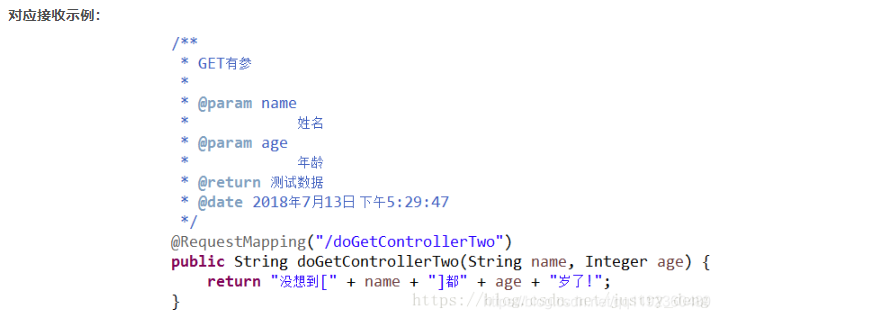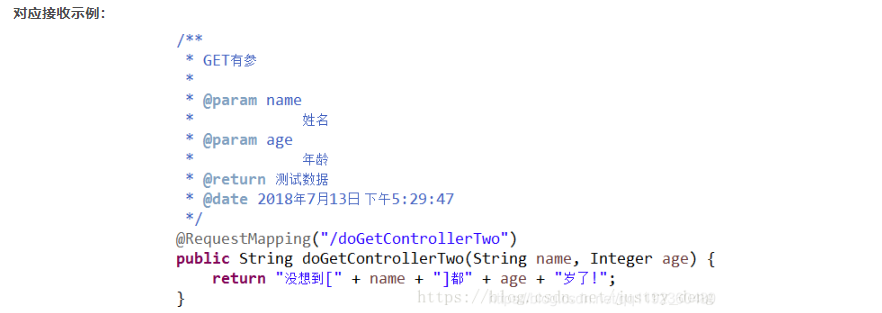Java使用代码调用接口http根据ip访问
HttpClient的主要功能:
实现了所有 HTTP 的方法(GET、POST、PUT、HEAD、DELETE、HEAD、OPTIONS 等)
支持 HTTPS 协议
支持代理服务器(Nginx等)等
支持自动(跳转)转向
详细使用示例
声明:此示例中,以JAVA发送HttpClient(在test里面单元测试发送的);也是以JAVA接收的(在controller里面接收的)。
声明:下面的代码,本人亲测有效。
GET无参:
HttpClient发送示例:
/** * GET---无参测试 * * @date 2018年7月13日 下午4:18:50 */ @Test public void doGetTestOne() { // 获得Http客户端(可以理解为:你得先有一个浏览器;注意:实际上HttpClient与浏览器是不一样的) CloseableHttpClient httpClient = HttpClientBuilder.create().build(); // 创建Get请求 HttpGet httpGet = new HttpGet("http://localhost:12345/doGetControllerOne"); // 响应模型 CloseableHttpResponse response = null; try { // 由客户端执行(发送)Get请求 response = httpClient.execute(httpGet); // 从响应模型中获取响应实体 HttpEntity responseEntity = response.getEntity(); System.out.println("响应状态为:" + response.getStatusLine()); if (responseEntity != null) { System.out.println("响应内容长度为:" + responseEntity.getContentLength()); System.out.println("响应内容为:" + EntityUtils.toString(responseEntity)); } } catch (ClientProtocolException e) { e.printStackTrace(); } catch (ParseException e) { e.printStackTrace(); } catch (IOException e) { e.printStackTrace(); } finally { try { // 释放资源 if (httpClient != null) { httpClient.close(); } if (response != null) { response.close(); } } catch (IOException e) { e.printStackTrace(); } } }
GET有参(方式一:直接拼接URL):
HttpClient发送示例:
/** * GET---有参测试 (方式一:手动在url后面加上参数) * * @date 2018年7月13日 下午4:19:23 */ @Test public void doGetTestWayOne() { // 获得Http客户端(可以理解为:你得先有一个浏览器;注意:实际上HttpClient与浏览器是不一样的) CloseableHttpClient httpClient = HttpClientBuilder.create().build(); // 参数 StringBuffer params = new StringBuffer(); try { // 字符数据最好encoding以下;这样一来,某些特殊字符才能传过去(如:某人的名字就是“&”,不encoding的话,传不过去) params.append("name=" + URLEncoder.encode("&", "utf-8")); params.append("&"); params.append("age=24"); } catch (UnsupportedEncodingException e1) { e1.printStackTrace(); } // 创建Get请求 HttpGet httpGet = new HttpGet("http://localhost:12345/doGetControllerTwo" + "?" + params); // 响应模型 CloseableHttpResponse response = null; try { // 配置信息 RequestConfig requestConfig = RequestConfig.custom() // 设置连接超时时间(单位毫秒) .setConnectTimeout(5000) // 设置请求超时时间(单位毫秒) .setConnectionRequestTimeout(5000) // socket读写超时时间(单位毫秒) .setSocketTimeout(5000) // 设置是否允许重定向(默认为true) .setRedirectsEnabled(true).build(); // 将上面的配置信息 运用到这个Get请求里 httpGet.setConfig(requestConfig); // 由客户端执行(发送)Get请求 response = httpClient.execute(httpGet); // 从响应模型中获取响应实体 HttpEntity responseEntity = response.getEntity(); System.out.println("响应状态为:" + response.getStatusLine()); if (responseEntity != null) { System.out.println("响应内容长度为:" + responseEntity.getContentLength()); System.out.println("响应内容为:" + EntityUtils.toString(responseEntity)); } } catch (ClientProtocolException e) { e.printStackTrace(); } catch (ParseException e) { e.printStackTrace(); } catch (IOException e) { e.printStackTrace(); } finally { try { // 释放资源 if (httpClient != null) { httpClient.close(); } if (response != null) { response.close(); } } catch (IOException e) { e.printStackTrace(); } } }

GET有参(方式二:使用URI获得HttpGet):
HttpClient发送示例
/** * GET---有参测试 (方式二:将参数放入键值对类中,再放入URI中,从而通过URI得到HttpGet实例) * * @date 2018年7月13日 下午4:19:23 */ @Test public void doGetTestWayTwo() { // 获得Http客户端(可以理解为:你得先有一个浏览器;注意:实际上HttpClient与浏览器是不一样的) CloseableHttpClient httpClient = HttpClientBuilder.create().build(); // 参数 URI uri = null; try { // 将参数放入键值对类NameValuePair中,再放入集合中 List<NameValuePair> params = new ArrayList<>(); params.add(new BasicNameValuePair("name", "&")); params.add(new BasicNameValuePair("age", "18")); // 设置uri信息,并将参数集合放入uri; // 注:这里也支持一个键值对一个键值对地往里面放setParameter(String key, String value) uri = new URIBuilder().setScheme("http").setHost("localhost") .setPort(12345).setPath("/doGetControllerTwo") .setParameters(params).build(); } catch (URISyntaxException e1) { e1.printStackTrace(); } // 创建Get请求 HttpGet httpGet = new HttpGet(uri); // 响应模型 CloseableHttpResponse response = null; try { // 配置信息 RequestConfig requestConfig = RequestConfig.custom() // 设置连接超时时间(单位毫秒) .setConnectTimeout(5000) // 设置请求超时时间(单位毫秒) .setConnectionRequestTimeout(5000) // socket读写超时时间(单位毫秒) .setSocketTimeout(5000) // 设置是否允许重定向(默认为true) .setRedirectsEnabled(true).build(); // 将上面的配置信息 运用到这个Get请求里 httpGet.setConfig(requestConfig); // 由客户端执行(发送)Get请求 response = httpClient.execute(httpGet); // 从响应模型中获取响应实体 HttpEntity responseEntity = response.getEntity(); System.out.println("响应状态为:" + response.getStatusLine()); if (responseEntity != null) { System.out.println("响应内容长度为:" + responseEntity.getContentLength()); System.out.println("响应内容为:" + EntityUtils.toString(responseEntity)); } } catch (ClientProtocolException e) { e.printStackTrace(); } catch (ParseException e) { e.printStackTrace(); } catch (IOException e) { e.printStackTrace(); } finally { try { // 释放资源 if (httpClient != null) { httpClient.close(); } if (response != null) { response.close(); } } catch (IOException e) { e.printStackTrace(); } } }

POST无参:
HttpClient发送示例:
/** * POST---无参测试 * * @date 2018年7月13日 下午4:18:50 */ @Test public void doPostTestOne() { // 获得Http客户端(可以理解为:你得先有一个浏览器;注意:实际上HttpClient与浏览器是不一样的) CloseableHttpClient httpClient = HttpClientBuilder.create().build(); // 创建Post请求 HttpPost httpPost = new HttpPost("http://localhost:12345/doPostControllerOne"); // 响应模型 CloseableHttpResponse response = null; try { // 由客户端执行(发送)Post请求 response = httpClient.execute(httpPost); // 从响应模型中获取响应实体 HttpEntity responseEntity = response.getEntity(); System.out.println("响应状态为:" + response.getStatusLine()); if (responseEntity != null) { System.out.println("响应内容长度为:" + responseEntity.getContentLength()); System.out.println("响应内容为:" + EntityUtils.toString(responseEntity)); } } catch (ClientProtocolException e) { e.printStackTrace(); } catch (ParseException e) { e.printStackTrace(); } catch (IOException e) { e.printStackTrace(); } finally { try { // 释放资源 if (httpClient != null) { httpClient.close(); } if (response != null) { response.close(); } } catch (IOException e) { e.printStackTrace(); } } }

POST有参(普通参数):
注:POST传递普通参数时,方式与GET一样即可,这里以直接在url后缀上参数的方式示例。
HttpClient发送示例:
/** * POST---有参测试(普通参数) * * @date 2018年7月13日 下午4:18:50 */ @Test public void doPostTestFour() { // 获得Http客户端(可以理解为:你得先有一个浏览器;注意:实际上HttpClient与浏览器是不一样的) CloseableHttpClient httpClient = HttpClientBuilder.create().build(); // 参数 StringBuffer params = new StringBuffer(); try { // 字符数据最好encoding以下;这样一来,某些特殊字符才能传过去(如:某人的名字就是“&”,不encoding的话,传不过去) params.append("name=" + URLEncoder.encode("&", "utf-8")); params.append("&"); params.append("age=24"); } catch (UnsupportedEncodingException e1) { e1.printStackTrace(); } // 创建Post请求 HttpPost httpPost = new HttpPost("http://localhost:12345/doPostControllerFour" + "?" + params); // 设置ContentType(注:如果只是传普通参数的话,ContentType不一定非要用application/json) httpPost.setHeader("Content-Type", "application/json;charset=utf8"); // 响应模型 CloseableHttpResponse response = null; try { // 由客户端执行(发送)Post请求 response = httpClient.execute(httpPost); // 从响应模型中获取响应实体 HttpEntity responseEntity = response.getEntity(); System.out.println("响应状态为:" + response.getStatusLine()); if (responseEntity != null) { System.out.println("响应内容长度为:" + responseEntity.getContentLength()); System.out.println("响应内容为:" + EntityUtils.toString(responseEntity)); } } catch (ClientProtocolException e) { e.printStackTrace(); } catch (ParseException e) { e.printStackTrace(); } catch (IOException e) { e.printStackTrace(); } finally { try { // 释放资源 if (httpClient != null) { httpClient.close(); } if (response != null) { response.close(); } } catch (IOException e) { e.printStackTrace(); } } }
POST有参(对象参数):
/** * POST---有参测试(对象参数) * * @date 2018年7月13日 下午4:18:50 */ @Test public void doPostTestTwo() { // 获得Http客户端(可以理解为:你得先有一个浏览器;注意:实际上HttpClient与浏览器是不一样的) CloseableHttpClient httpClient = HttpClientBuilder.create().build(); // 创建Post请求 HttpPost httpPost = new HttpPost("http://localhost:12345/doPostControllerTwo"); User user = new User(); user.setName("潘晓婷"); user.setAge(18); user.setGender("女"); user.setMotto("姿势要优雅~"); // 我这里利用阿里的fastjson,将Object转换为json字符串; // (需要导入com.alibaba.fastjson.JSON包) String jsonString = JSON.toJSONString(user); StringEntity entity = new StringEntity(jsonString, "UTF-8"); // post请求是将参数放在请求体里面传过去的;这里将entity放入post请求体中 httpPost.setEntity(entity); httpPost.setHeader("Content-Type", "application/json;charset=utf8"); // 响应模型 CloseableHttpResponse response = null; try { // 由客户端执行(发送)Post请求 response = httpClient.execute(httpPost); // 从响应模型中获取响应实体 HttpEntity responseEntity = response.getEntity(); System.out.println("响应状态为:" + response.getStatusLine()); if (responseEntity != null) { System.out.println("响应内容长度为:" + responseEntity.getContentLength()); System.out.println("响应内容为:" + EntityUtils.toString(responseEntity)); } } catch (ClientProtocolException e) { e.printStackTrace(); } catch (ParseException e) { e.printStackTrace(); } catch (IOException e) { e.printStackTrace(); } finally { try { // 释放资源 if (httpClient != null) { httpClient.close(); } if (response != null) { response.close(); } } catch (IOException e) { e.printStackTrace(); } } }

POST有参(普通参数 + 对象参数):
注:POST传递普通参数时,方式与GET一样即可,这里以通过URI获得HttpPost的方式为例。
/** * POST---有参测试(普通参数 + 对象参数) * * @date 2018年7月13日 下午4:18:50 */ @Test public void doPostTestThree() { // 获得Http客户端(可以理解为:你得先有一个浏览器;注意:实际上HttpClient与浏览器是不一样的) CloseableHttpClient httpClient = HttpClientBuilder.create().build(); // 创建Post请求 // 参数 URI uri = null; try { // 将参数放入键值对类NameValuePair中,再放入集合中 List<NameValuePair> params = new ArrayList<>(); params.add(new BasicNameValuePair("flag", "4")); params.add(new BasicNameValuePair("meaning", "这是什么鬼?")); // 设置uri信息,并将参数集合放入uri; // 注:这里也支持一个键值对一个键值对地往里面放setParameter(String key, String value) uri = new URIBuilder().setScheme("http").setHost("localhost").setPort(12345) .setPath("/doPostControllerThree").setParameters(params).build(); } catch (URISyntaxException e1) { e1.printStackTrace(); } HttpPost httpPost = new HttpPost(uri); // HttpPost httpPost = new // HttpPost("http://localhost:12345/doPostControllerThree1"); // 创建user参数 User user = new User(); user.setName("潘晓婷"); user.setAge(18); user.setGender("女"); user.setMotto("姿势要优雅~"); // 将user对象转换为json字符串,并放入entity中 StringEntity entity = new StringEntity(JSON.toJSONString(user), "UTF-8"); // post请求是将参数放在请求体里面传过去的;这里将entity放入post请求体中 httpPost.setEntity(entity); httpPost.setHeader("Content-Type", "application/json;charset=utf8"); // 响应模型 CloseableHttpResponse response = null; try { // 由客户端执行(发送)Post请求 response = httpClient.execute(httpPost); // 从响应模型中获取响应实体 HttpEntity responseEntity = response.getEntity(); System.out.println("响应状态为:" + response.getStatusLine()); if (responseEntity != null) { System.out.println("响应内容长度为:" + responseEntity.getContentLength()); System.out.println("响应内容为:" + EntityUtils.toString(responseEntity)); } } catch (ClientProtocolException e) { e.printStackTrace(); } catch (ParseException e) { e.printStackTrace(); } catch (IOException e) { e.printStackTrace(); } finally { try { // 释放资源 if (httpClient != null) { httpClient.close(); } if (response != null) { response.close(); } } catch (IOException e) { e.printStackTrace(); } } }









【推荐】国内首个AI IDE,深度理解中文开发场景,立即下载体验Trae
【推荐】编程新体验,更懂你的AI,立即体验豆包MarsCode编程助手
【推荐】抖音旗下AI助手豆包,你的智能百科全书,全免费不限次数
【推荐】轻量又高性能的 SSH 工具 IShell:AI 加持,快人一步
· 阿里最新开源QwQ-32B,效果媲美deepseek-r1满血版,部署成本又又又降低了!
· 开源Multi-agent AI智能体框架aevatar.ai,欢迎大家贡献代码
· Manus重磅发布:全球首款通用AI代理技术深度解析与实战指南
· 被坑几百块钱后,我竟然真的恢复了删除的微信聊天记录!
· 没有Manus邀请码?试试免邀请码的MGX或者开源的OpenManus吧